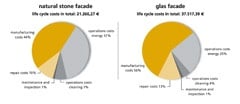Stone facades are more energy efficient and less expensive than glass
The Frankfurt Opera Tower, with its natural stone facades, was one of the first buildings in Europe to achieve Gold Status in the LEED rating system of the US Green Building Council.
It has prompted EuroRoc, the international confederation of natural stone industries, to carry out a study to compare the energy efficiency of stone facades with all-glass facades.
Stone has many advanateges over glass in the life-cycle analysis used by EuroRoc. It requires less energy to extact and process, it is low maintenance over an extended period, and it is easily recyclable.
Comparing glass with stone over a 100 year period, glass uses about 40% more energy to make and more than eight times more energy to maintain.
At the Frankfurt Opera Tower with its 30,000m2 of facade, EuroRoc has considered the actual ventilated stone facade used against a supposed all-glass facade. It determines that the primary energy requirements of having an all-glass facade would be double what was actually required for the stone option.
In use, a stone facade has a heat transfer coefficient of 0.32W/m2 compared with 1.25W/m2 for glass, which will considerably reduce the summer cooling and winter heating energy requirements, although these have not been considered in the EuroRoc report. Instead, it restricts itself to the energy requirements of the materials themselves in production, construction, maintenance and recycling.
And it is not just on energy that glass loses out to stone. It is also on cost. Construction costs using glass rise in proportion to the amount of glass used. While a ventilated stone facade with 35% glass for windows costs €400 per square metre, a facade with 90% glass costs €1,280 per square metre.
To download a PDF of the EuroRoc report, click below.

